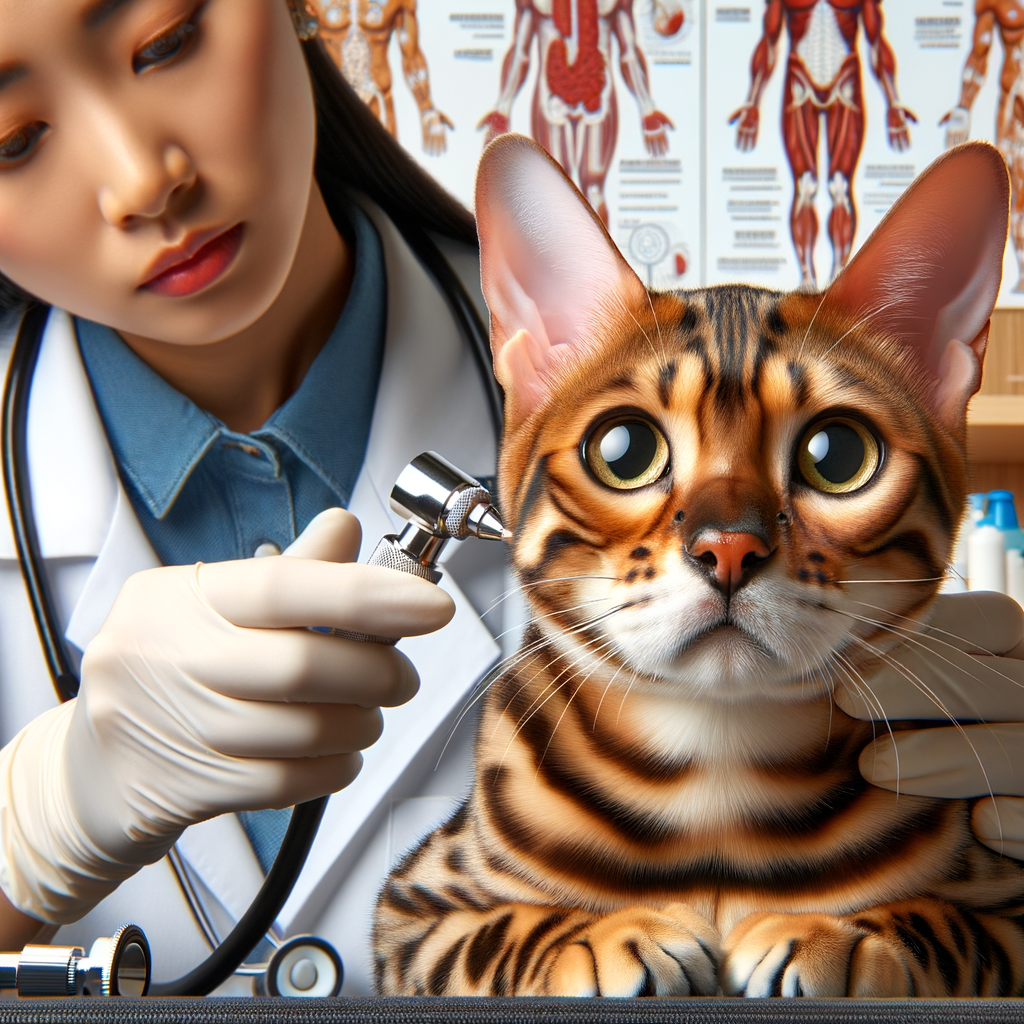
Introduction to Bengal Cat Ear Health
-
Importance of ear health in Bengal cats:
Healthy ears help them hear well and stay balanced. Regular ear checks can prevent serious problems.
-
Overview of common ear problems in Bengal cats:
These include ear mites, infections, and wax buildup. Knowing these problems helps in early detection and treatment.
Recognizing Bengal Cat Ear Infection Symptoms
Physical Signs of Ear Infection in Bengal Cats
Know the physical signs of ear infections in Bengal cats. These signs can help you catch an infection early and get your cat the help it needs.
-
Redness and swelling:
If you notice your cat’s ears are red and swollen, it could be a sign of an infection. Healthy ears should be a pale pink color.
-
Discharge from the ear:
Look for any unusual discharge coming from your cat’s ears. This can be a sign of an infection. The discharge might be yellow, brown, or even black.
-
Unpleasant smell:
A bad smell coming from your cat’s ears is another sign of an infection. Healthy ears should not have a strong odor.
By recognizing these physical signs, you can help keep your Bengal cat healthy and happy.
Behavioral Signs of Ear Infection in Bengal Cats
-
Excessive scratching of the ear:
If your Bengal cat is constantly scratching its ear, it could be a sign of an ear infection. Cats usually scratch when they feel discomfort or itchiness. Watch for persistent scratching, as it can lead to further irritation and even injury.
-
Shaking the head frequently:
Another common behavior is frequent head shaking. This is your cat’s way of trying to relieve the discomfort caused by the infection. If you notice your Bengal cat shaking its head more than usual, it might be time for a vet visit.
-
Unusual aggression or irritability:
This pain can make your usually friendly Bengal cat act out. They might become more aggressive or irritable. Pay attention to sudden changes in behavior, as these can be clues to their health.
Causes of Ear Infections in Bengal Cats
Ear infections in Bengal cats can be caused by several factors. Understanding these causes can help in preventing and treating infections effectively.
-
Parasites such as ear mites:
Ear mites are tiny parasites that live in the ear canal. They can cause itching, redness, and discharge. These mites are highly contagious and can spread from one pet to another.
-
Bacterial or yeast infections:
Bacteria and yeast can grow in the ear, especially if the ear is moist. This can lead to an infection that causes pain, swelling, and a bad smell. Regular cleaning can help prevent these infections.
-
Allergies or skin conditions:
Allergies to food, pollen, or other substances can cause ear problems. Skin conditions like dermatitis can also lead to ear infections. Identifying and managing these allergies or conditions is crucial for ear health.
Bengal Cat Ear Infection Treatment
Professional Treatment for Bengal Cat Ear Infections
When your Bengal cat has an ear infection, professional treatment is often necessary. Here are the key steps:
-
Consulting a vet for diagnosis:
The first step is to take your Bengal cat to the vet. The vet will examine your cat’s ears to determine the cause of the infection. This may include looking for signs of mites, bacteria, or yeast. Early diagnosis can prevent more serious problems.
-
Prescribed medications:
These can include antibiotics for bacterial infections, antifungal treatments for yeast infections, or anti-parasitic medications if ear mites are found. Follow the vet’s instructions carefully to ensure your cat’s recovery.
-
Potential surgical treatments:
In severe cases, surgery might be needed. This is rare but can happen if the infection is very serious or if there are complications. The vet will discuss this option with you if it is necessary.
Home Remedies for Bengal Cat Ear Infections
Ear infections in Bengal cats can be uncomfortable for your furry friend. There are also home remedies you can try. Here are some effective methods:
-
Cleaning the cat’s ears regularly:
Use a gentle ear cleaner made for cats. Gently wipe the inside of the ear with a cotton ball. Do this once a week to prevent infections.
-
Using over-the-counter ear drops:
There are ear drops available at pet stores that can help with mild infections. Follow the instructions on the package. If the infection doesn’t improve, consult your vet.
-
Applying natural remedies such as coconut oil:
Coconut oil has natural antibacterial properties. Warm a small amount and apply it to the inside of the ear with a cotton ball. This can help soothe and heal the infection.
These remedies can be helpful, but always monitor your cat’s condition. If the infection persists, it’s best to seek professional veterinary care.
Preventing Ear Infections in Bengal Cats
Here are some tips to prevent ear infections:
-
Regular ear cleaning:
Clean your cat’s ears once a week. Use a vet-approved ear cleaner. Gently wipe the inside of the ear with a cotton ball. Do not use cotton swabs as they can hurt the ear.
-
Proper diet and hydration:
Feed your Bengal cat a balanced diet. Ensure they drink enough water. Good nutrition helps keep their immune system strong, which can prevent infections.
-
Regular vet check-ups:
Take your cat to the vet at least once a year. Regular check-ups can catch ear problems early. Your vet can also give you advice on ear care.
By following these steps, you can help keep your Bengal cat’s ears healthy and free from infections.
Best Treatments for Bengal Cat Ear Infections
-
Topical medications:
These are medicines you apply directly to your cat’s ears. They often come in the form of drops or ointments. Topical medications can help reduce inflammation and kill bacteria or yeast causing the infection. Always follow your vet’s instructions when using these treatments.
-
Oral medications:
Sometimes, your vet may prescribe pills or liquid medicine for your Bengal cat. These oral medications can help fight off the infection from the inside. They are especially useful if the infection is severe or has spread beyond the ear.
-
Surgery in severe cases:
In rare and extreme cases, surgery might be needed. This usually happens if the infection is very bad and doesn’t get better with other treatments. Surgery can help remove damaged tissue and allow the ear to heal properly.
Bengal Cat Ear Care
- Importance of Regular Ear Care
Clean ears help prevent infections and ensure your cat stays healthy. Make ear checks a part of your routine.
- Recap of Signs and Treatments of Ear Infections
Watch for signs like scratching, redness, or a bad smell. If you notice these, consult your vet. Treatments often include ear drops and cleaning solutions.
- Final Advice for Bengal Cat Owners
Keep your Bengal cat’s ears clean and check them often. Early detection and treatment can save your cat from discomfort. Always follow your vet’s advice.
| Key Points | Details |
|---|---|
| Regular Ear Care | Prevents infections, keeps ears healthy |
| Signs of Infections | Scratching, redness, bad smell |
| Treatments | Ear drops, cleaning solutions |
| Final Advice | Check ears often, follow vet’s advice |






